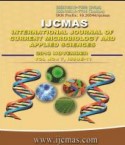


 National Academy of Agricultural Sciences (NAAS)
National Academy of Agricultural Sciences (NAAS)

|
PRINT ISSN : 2319-7692
Online ISSN : 2319-7706 Issues : 12 per year Publisher : Excellent Publishers Email : editorijcmas@gmail.com / submit@ijcmas.com Editor-in-chief: Dr.M.Prakash Index Copernicus ICV 2018: 95.39 NAAS RATING 2020: 5.38 |
A field experiment was conducted at Horticultural Research Station, Adilabad during kharif, 2015 and 2016 to study the effect of integrated nutrient management practices on dry matter production and nutrient uptake by baby corn in baby corn-hyacinth bean cropping system. The experiment was laid out in a randomized block design for baby corn during kharif, 2015 season with seven treatments comprised of 25% N supplemented through FYM or vermicompost + 75% RDF (Recommended dose of fertilizer150:60:60 N, P2O5 and K2O ha-1) with or without Azospirillum and Bacillus megaterium @ 5 kg ha-1 each and control (no fertilizer application) and replicated thrice. Each main treatment was divided into four sub plots and the treatments of 100% RDF and 75% RDF with or without Bradyrhizobium @ 500 g ha 1 (seed treatment), were imposed to hyacinth bean in rabi season and data of kharif, 2016 was analyzed in split plot design. Application of vermicompost (25% N) in combination with 75% RDF along with bio-fertilizers recorded significantly higher DMP over rest of the treatments at all growth periods of study during both the years except that 15 DAS in which it was on par with other treatments. Use of bio-fertilizers to baby corn in conjunction with 100% or 75% RDF integrated with 25% N through FYM and 75% RDF integrated with 25% N through vermicompost resulted in significantly higher DMP at 30 and 45 DAS over un-fertilized control, 100% RDF and 75% RDF integrated with 25% N through FYM during both the years of study. Combined application of 75% RDF and 25% N through vermicompost in-additions bio-fertilizers incorporation showed significantly higher N, P and K uptake over integration of 75% RDF with 25% N through vermicompost, integration of 75% RDF with 25% N through FYM with or without bio-fertilizer, 100% RDF with or without bio-fertilizer and un-fertilized control.
 |
 |
 |
 |
 |